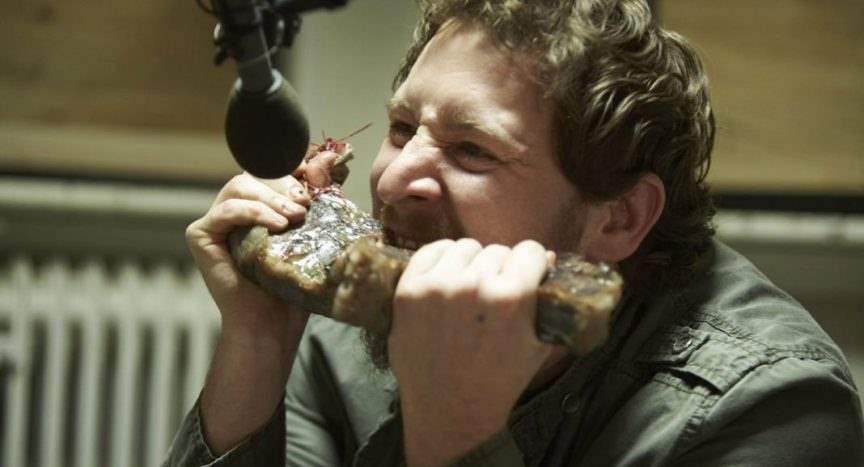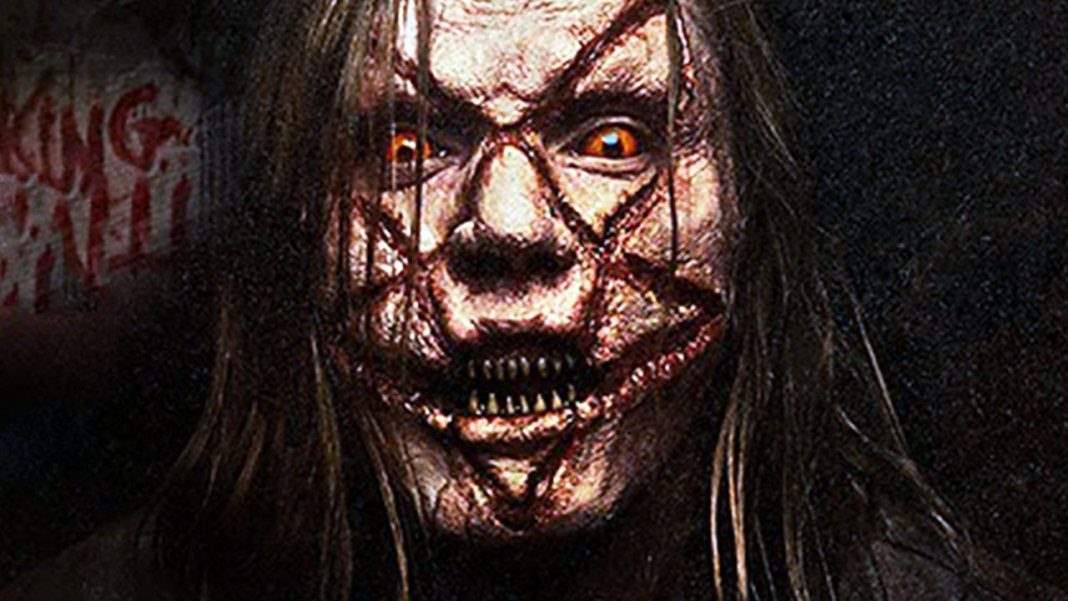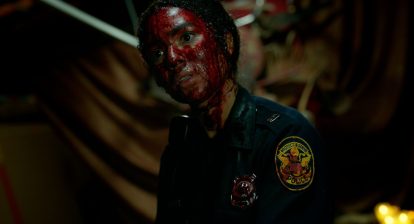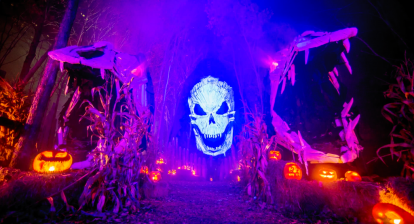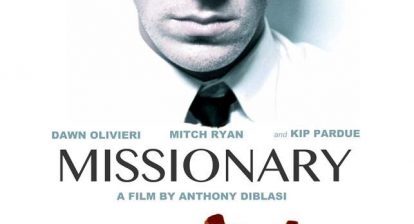Anthony DiBlasi is one of the most prolific filmmakers working in horror today. With a diverse filmography that includes religious thriller Missionary, old-school slasher Most Likely To Die, and the single-location shocker Last Shift, DiBlasi has consistently surprised audiences with each new venture.
The L.A.-based writer, director, and producer has been working away quietly in the background for years, but with his new movie Extremity, he stakes a claim for himself as one of the coolest and most original voices in genre cinema. Forget Wan, forget Blumhouse, DiBlasi is the real deal.
Wicked Horror got the perennially charming DiBlasi on the phone first thing in the morning for a lengthy chat about his new movie, the popularity of so-called extreme haunts, and his thoughts on the future of women in horror.
WH: Right. I caught the movie a while back at this stage so quickly give me the elevator pitch. What is the premise of Extremity? Pretend I know absolutely nothing about it.
Anthony DiBlasi: [faux outraged] Oh my god! You don’t remember the movie! [laughs] Okay, so it’s about a character named Allison, who goes to this extreme haunt to face her demons. Then, once she’s there, we start to learn all this stuff about her past, her father, all these kinds of things. That’s the basic premise of it.
WH: The villain, Red Skull, who kind of runs the facility Allison visits, is definitely a misogynistic character. Do you feel like the film itself is misogynistic? ‘Cause it could certainly be read that way.
Anthony DiBlasi: That’s a good question. The way I see it, the film is deliberately misogynistic, because the haunt itself is so misogynistic. That’s the big reveal; that this guy knows exactly what he’s doing, and that he’s enjoying it. In this #MeToo era, it’s tough to sell a movie with a female being tortured for 40 minutes like this, but it’s intentional because this guy is so obviously a misogynist.
WH: It’s tough with horror, because as horror fans, we like extreme cinema, we like to push those boundaries. I caught Incident In A Ghostland at Frightfest and I feel like there’s a massive difference between that kind of movie and something like Extremity, which is very definitively condemning this kind of behaviour.
Related: Incident in a Ghostland is Vile and Ill-Timed [FrightFest 2018 Review]
Anthony DiBlasi: There’s definitely a line, but I think things are changing and maybe it’ll turn out to be a separation between male and female fans of the genre. The male fans are always going to be into a certain type of film, but the women won’t be willing to sit through it anymore.
WH: Extremity is centered on an extreme haunt, so obviously we have to talk about McKamey Manor, the most infamous extreme haunt of all. Are you aware of McKamey Manor?
Anthony DiBlasi: Absolutely. You know, it’s funny, when I was first sent the script for Extremity, it was actually called The Manor. There was as lot of influence from McKamey Manor. I liked a lot of the stuff in it, I thought it was a nice bookend to Dread, it had a lot of the same themes. I knew about McKamey Manor, of course. But when I started researching extreme haunts, and McKamey himself, I realised this stuff is all physical, and I wanted to bring in more of the psychological aspect. So I reached more into the Blackout world. Blackout actually has a great documentary about it, called The Blackout Experiment, which is really interesting. You should watch it, if you haven’t already. You think it’s about the haunt but it’s not, it’s actually about the people who go there, and who become obsessed with these places. McKamey doesn’t deal with the sexual stuff at all, but Blackout is very psycho-sexual. Now, McKamey, because his haunt is so physical, he kind of stays away from that stuff – probably because he wants as few lawsuits as possible – but there’s a documentary called Haunters: The Art of the Scare –

WH: I saw that! I actually reviewed it, too. It was really great.
Anthony DiBlasi: Right, so I’ve gotten to know Jon [Schnitzer – director] quite well lately. He actually interviews me on the Blu-ray for Extremity, we talk about extreme haunts and stuff. He told me that McKamey is even darker than they portrayed him in the movie. They’re definitely not faking that stuff at McKamey Manor. And there are a lot of problems, you know, with the people that work there, because you know how he’s like ‘oh we do background checks and you need a doctor’s note,’ that’s all bullshit. [laughs] He lets whoever in! A lot of the people working there are totally off their rocker. He’s had lots of issues. This extreme haunt world just opens you up to all kinds of stuff.
WH: Yeah, I actually thought there was too much of McKamey in that documentary [Haunters: The Art Of The Scare]. It almost painted him in a sympathetic light, especially when he couldn’t get his second location going.
Anthony DiBlasi: McKamey Manor is definitely not…fun. McKamey himself is ex-military and his tactics are very procedural. If you pull someone’s hair twenty times in a row, or smack them in the face twenty times, their adrenaline is going and they’re starting to have a panic attack. That’s all it is, pure physicality. There’s a Netflix show called Dark Tourist and McKamey is on that, too. The interview process is featured on that, more heavily than it was in Haunters, as well as the contract signing process. That process takes five hours. So you’re literally there for five hours with McKamey, sitting there going through every line of this contract that says ‘you’re gonna die if you do this’ and then…you do it! So people are already exhausted before it even begins. They’re already f****d up.
WH: Would you ever do it?
Anthony DiBlasi: Me, personally? No, I would never do McKamey Manor. I would do Blackout, you know ‘cause it’s more immersive, and they touch you and stuff, but at least if you want it to stop they have a safe word.
WH: It’s worrying McKamey doesn’t [have a safe word]…
Anthony DiBlasi: I think he’s been forced to have one now. Since that documentary came out… I mean, he’s had tons of problems, he can barely run it anymore. Everywhere he goes, his neighbours put up cease and desist orders against him.
WH: That’s understandable. Imagine living next to someone and hearing non–stop screaming the whole time. It takes, like, eight hours too. That was the longest someone lasted, wasn’t it?
Anthony DiBlasi: He just does it until they break. He does it for as long as it takes.

WH: So McKamey Manor definitely was an influence on Extremity then? At least in the beginning?
Anthony DiBlasi: Yeah, McKamey, Blackout, Heretic, the ones that are really extreme-extreme haunts. Most people don’t even know about these things. Maybe in our world they do, but my agent and her husband, for example, watched the movie and they couldn’t believe these things are real. Or that anyone would want to do them.
WH: So was it the real-world aspect that attracted you to the movie? Or was it the psychological elements, you know, this girl’s journey?
Anthony DiBlasi: For sure the psychological stuff. We added so much of that stuff, as well as her backstory, the things she’s battling along the way, because none of that stuff was in the original script and that’s what I personally find fascinating. The psychology behind the people who run it and the people who wanna go through it, and how those two things collide. It’s a cautionary tale, too, it’s saying ‘you don’t know what you’re getting into’ but also ‘you don’t know who you’re letting in.’
WH: The guy running it is a great villain, particularly for our time, as you said right at the top of our chat.
Anthony DiBlasi: I think you get a good look into why he does this, over the course of the movie, and the contrast between why he tells people he does it and why he really does it, which you only really find out at the end. There are all these layers you deal with along the way. And I think you see that in Haunters, too. John actually got a lot of flak for making McKamey as sympathetic as possible, as you said yourself. Especially from the other haunts, because they’re definitely not fans of McKamey Manor.
WH: I can understand why. I don’t even think it’s a real haunt, in the truest sense of the word.
Anthony DiBlasi: There are tons of those places out there now, too, it’s just that people don’t necessarily know about them. McKamey has been doing this for the past 20 years or something, but it’s only in the last two or three that people have started talking about him. The whole extreme haunt thing is starting to gain traction, as people start to figure out what it even is, and start to get more involved in it. But there are tons of them all over the world. They’re totally unregulated, too.
WH: I’ve been following on social media all these behind the scenes shots from the shoot and it looks like it was absolutely freezing. Was that the hardest part, the extreme…weather?
Anthony DiBlasi: [laughs] Oh for sure, the weather was the hardest part definitely! It was the dead of winter, the worst part of the winter, ’cause it was January/February time in the Alberta region. We weren’t far from where they shot The Revenant, actually. In those conditions, you have to wait for the okay to even go outside, because there are days when it’s too cold to even go out there. We shot a lot of the outdoors stuff on a frozen lake and the actors were clothed, of course, but they weren’t that clothed, and they didn’t have gloves on or anything. There were heating tents set up, for them to run into between shots. We were waiting around a lot to get those shots. Strangely enough, those outdoor shots weren’t even the coldest part of the shoot. We shot most of the movie in an asylum, a working asylum, on a huge plot of land, with dozens of buildings surrounding it. Several were condemned, some since the 1970s, and there were all these wings with cell-blocks and stuff. So we shot in those buildings, in a working asylum, or mental institution, with both juvenile and adult facilities, both minimum and maximum security. You could walk up to the maximum security wing and there were actual serial killers in there. All around the campus, the inmates, the lower security ones, were just walking around. They’d come up to you looking for a hug or to bum a cigarette or just wanting to talk to you. It was a very…weird experience. I was just like ‘why are they even letting us do this!?’

WH: It’s funny, because it looks totally deserted in the movie. You’d never know that just outside the frame there was this active world.
Anthony DiBlasi: It’s weird because they’re all connected by tunnels below and above ground. You go down this long hallway, it’s totally decrepit, and then turn down another corner, go down another hallway and suddenly whoa! We’re in an active part of the facility! Sometimes we’d go out there to use the restrooms, but the actors couldn’t walk around in their costumes because they were concerned that it might incite the residents there. You have to be careful about locking the doors, so they don’t get into where we’re shooting – just because they could be a harm to themselves – and we had to be mindful going to the bathroom, especially the girls, who had to go in pairs ‘cause someone could just walk in and you don’t know who it’s gonna be.
WH: Were there any incidents, or were you guys okay?
Anthony DiBlasi: Nothing major. Some of the male inmates would follow the girls to the restrooms and stuff, so we started having them escorted with a guard, just in case. But those locations, inside those buildings, particularly the area where we shot the pit of doom sequence, which is kind of like the fun-house sequence, that was so cold, it was way colder than being outside. It was all cement, it had been shut down since the seventies, nothing was working, and it had just been collecting…cold. I don’t even know how to explain it, it was just so cold. We dropped blood on the ground and it froze instantaneously. That was the coldest I’ve ever felt.
WH: The two leads, Red Skull and Allison, how did you go about casting those two roles?
Anthony DiBlasi: We cast in Los Angeles first, then moved on to Canada. It was a Canadian production, so we were limited about who we could bring up from the States. We tried to cast locally as much as we could, ‘cause there’s such a wealth of talent in Vancouver and Calgary, there’s so much production in those areas, so that’s where we cast the two leads, Dana [Christina], who plays Allison, and Chad [Rook], who plays the Red Skull character. Dana was shortlisted right away for the girlfriend character, the Erica character, and then as time went on, things weren’t working out so I figured Dana was a great choice. She was local, so it would make things much easier, but then when I sat down with her, she was so enthusiastic about just diving into it. It wasn’t an easy role for her in any way. I wasn’t looking to fake anything. They’re doing it for real at these haunts, so we’re going to do it for real here. We had a stunt-person obviously, but for example the waterboarding stuff, we just waterboarded her. It was a really demanding role, physically, as well as constantly running around in the snow and the ice, and then falling in the snow and the ice. Kelsey, who plays Morgan, it was taxing for her, too, being choked out by these girls the whole time. Allison was a really physical role and Dana was just excited to jump into it.
WH: It was very emotionally taxing too, I’m sure.
Anthony DiBlasi: Absolutely, and she’s in almost every scene. It’s funny, I remember her coming in day one to do flashback stuff. They were very easy scenes, it was warm, and then to watch her break down over the course of the shoot…it really was like the actor and the character both got crazier in a way, over the course of the movie.
WH: Extremity is a very female-focused film, with a deliberate rumination on misogyny, as you said. Do you feel like the future of horror is female?
Anthony DiBlasi: The future is female! A lot of people are asking the question right now, but for me, I’ve always felt that horror has been female. Horror is way ahead of the curve when it comes to strong female characters. Particularly in the eighties, horror was the one genre where the women were always the heroes. It was rare to see a horror movie that didn’t have a female lead. So I think everyone else is catching up with the horror genre right now. People underestimate how many women like horror movies, too. They’re always surprised, but women dominate horror. They always have.

WH: There’s been a shift towards more female stories in horror too. A female-led, female-directed horror movie [The Ranger] opened Frightfest this year. The first one ever in 20 years, which is pretty shocking, but still it’s all progress.
Related: The Ranger is Bloody, Smart, and Unpredictable [FrightFest 2018 Review]
Anthony DiBlasi: That’s for sure happening. There’s a concerted effort to make sure you’re being conscientious of your programming, what you’re buying, who you’re hiring. A lot of women are feeling more comfortable that they’ll have more of a shot. It’s weird for me, as a guy on the inside, having worked in the studio system also, like you just didn’t see a lot of women. When we were doing work with Clive [Barker], there weren’t a lot of women knocking at our door, making movies, or submitting movies. So I think that’s changed.
WH: There was push-back at certain festivals this year. Venice and even Cannes, the festival directors were against just having women for the sake of it.
Anthony DiBlasi: [laughs] That’s always a weird stance to take! Obviously, there’s an argument to be made against just taking some random girl off the street to fill some sort of quota but if you look, you’ll find plenty of working women in the genre or even outside of the genre who make movies and TV.
WH: Surely it’s just about the best person getting in. It just doesn’t make any sense.
Anthony DiBlasi: Yeah the guy in Venice is just pushing back like ‘we don’t want more women here!’
WH: What more do you want from us!? We have a woman! She’s over there! Can’t you see her!?
Anthony DiBlasi: [laughing] Exactly! Even for me, doing Extremity, Scott Swan [co-writer on the movie] was transitioning over the course of production. So Scott is now Rebecca Swan. And I’ve known Scott a long time, he was one of the writers on Dread when it was at FOX, and he’s a really great person. So he had transitioned, meaning he had a really great point of view about the misogyny and how deliberate it was. It was meant to trigger this girl, and if you go back and watch it, you’ll see how these things are laid in along the way. We had such a cool cast of girls in the movie, too, the first time I’d ever made a movie with so many women acting in it and working on it. It was like The Breakfast Club. I had such an eclectic group of people who really got along. Dana is also a doctor, Ashley Smith is a fashion model, Nikki [Rae Hallow] is a touring comedian, Camille [Cam Damage] is a fetish artist, and then Kelsey [Andries] is an MMA fighter. So none of them were actresses first and foremost. So they bonded really well, it was such a cool dynamic, because we were stranded up there, some of them were even living together, and it was so cool for me just to witness that.
WH: How do you feel like Extremity fits into your filmography?
Anthony DiBlasi: When I got onboard, it was because I saw it as a bookend to Dread, so in a lot of ways it felt like closing a chapter I started ten years ago when I made that movie. It deals with a lot of the same themes, especially someone doing something extreme to get over their own traumas, so it felt like a second part of telling the story from a different point of view. So, yeah, the closing of a chapter definitely. What will come next, I’m not sure [laughs].

WH: Well there goes my final question.
Anthony DiBlasi: Strangely enough, the thing I’m writing right now is kind of a quirky drama, kind of in the vein of Eternal Sunshine of the Spotless Mind. I’m focusing on writing at the moment, because it’s been a long time since I’ve been able to make something I’ve written, not since Last Shift, and I always prefer doing things that I write. You’re so much more intimate with the material that way.
WH: Would you ever do a big studio sequel, like Corin Hardy just did with The Nun?
Anthony DiBlasi: I wouldn’t be against doing that. I mean, I pick random things for weird reasons.
WH: To your credit, your back catalogue is so varied. There’s no real through-line, they’re all so different.
Anthony DiBlasi: Totally. I like drama, I’m not averse to making drama, I love horror obviously. So, who knows? It’s either going to be seen as my great strength or my great weakness eventually, like ‘you should’ve stuck to this one thing!’ That’s the hard thing with movies like Extremity and Dread, because at their heart, they’re more than just horror movies. Dread was not middle of the road when it came to reviews, it was either ‘I love this movie’ or ‘I despise this movie.’ It always created some kind of visceral response in people. I think Extremity is going to be much the same, because people are going to go in expecting it to be scary. And it’s definitely more psychological than scary. People don’t want that from a horror movie, they want to be put on a roller-coaster. Which is fine, too, and it’s why I made Last Shift. Now that is a scary movie.
WH: It really is. I still haven’t forgiven you for that one.
Anthony DiBlasi: [laughs] Well, Extremity should soften the blow. When you eventually watch it again, that is!
This interview has been edited and condensed. Catch Extremity on Blu-ray and VOD from October 2, 2018
